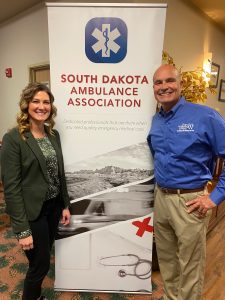 It is finally here. Fifty (50%) of the EMS organizations will begin collecting ground ambulance cost data in 2022 for reporting by May 2023. The other half of the EMS organizations will collect their data beginning in 2023 for reporting by May 2024. All of this, to comply with the new CMS Ground Ambulance Data Collection System. For the last several years, the AAA and the ACE faculty have been performing workshops and webinars about these new cost collection requirements because the data collected will be used to reform the Medicare Fee Schedule and the way EMS organizations are reimbursed for years to come.
It is finally here. Fifty (50%) of the EMS organizations will begin collecting ground ambulance cost data in 2022 for reporting by May 2023. The other half of the EMS organizations will collect their data beginning in 2023 for reporting by May 2024. All of this, to comply with the new CMS Ground Ambulance Data Collection System. For the last several years, the AAA and the ACE faculty have been performing workshops and webinars about these new cost collection requirements because the data collected will be used to reform the Medicare Fee Schedule and the way EMS organizations are reimbursed for years to come.
We wanted to highlight the steps that EMS organizations should be taking today to facilitate the collection of accurate cost-related data. Due to the way the Ambulance Cost Data Collection Instrument asks for certain information, it will be necessary for you and your team to capture some data at the beginning of the collection period. It will be difficult, if not impossible, for organizations to retroactively capture this data.
2. Access Amber
Knowing that there are significant differences amongst EMS organizations when it comes to the various processes and software platforms where cost data might be housed, the AAA decided to create a software platform specifically designed for the new Medicare Ground Ambulance Cost Data Collection System. Amber is a web-based software built to model the CMS Cost Collection Tool and follows the same skip-logic. EMS organizations can start and stop, go back, adjust, and validate your data before submitting it to CMS. The built-in error checker makes it easy to identify mistakes, or possible mistakes, and make corrections.
AAA members already have access to Amber as part of their membership, but Amber is available to all EMS services regardless of AAA membership or service type. To log in or request free access, visit https://emsamber.com/.
2. Verify the Information in PECOS
PECOS is the Provider Enrollment and Chain of Ownership System utilized by Medicare for provider enrollment and revalidation. It is important that the organization verify all the data about their organization in PECOS but specifically the ownership, contact address, and managing employee information. You want to ensure that CMS has the correct contact information in case they need to notify your organization relative to your cost data collection process. If your organization was selected but you have not been notified by your Medicare Administrative Contractor (MAC), it could be because your information is not up to date.
3. Contact Your Medicare Administrative Contractor (MAC)
If you were selected for data collection in 2022, you should have already received a notification from your MAC. This notification includes that your organization was selected and that you need to notify the MAC whether your organization will report on a calendar or fiscal year. Whether you have received this notification or not, you should contact your MAC to confirm this information and ensure that they have noted your collection year in their system. If you do not, the default designation is reporting on a calendar year. You will create additional work if this is not how your organization currently accounts for your financial data.
4. Snapshot of Personnel
Section 7 of the Medicare Ground Ambulance Cost Data Collection Instrument seeks information about the labor costs at your EMS organization. Organizations will be providing the total compensation and hours for their employees by employee category.
However, the Instruments asks organizations to report individuals based upon the position they held at the start of the data collection period. If an employee progresses from an EMT to Paramedic during the course of the year, the instrument requires that the new paramedic’s hours and compensation be in the EMT category.
There are a few possible ways that organizations can ensure that they report their labor costs consistent with the Instrument’s instructions. The easiest is to take a snapshot of the personnel roster at the beginning of the data collection year. Ensure that any employee who changes position during the year be tagged and reported appropriately. Many of the scheduling software platforms have existing additional “other” identifier field in the administration set up for employees. Also, most payroll software platforms have canned reports in their reporting suite that identifies employees with status changes during a particular period. Lastly, you can simply keep a list of any employee who, for reporting purposes, you need to go back and adjust your compensation and hour reporting to ensure you have accounted for their costs consistent with the Cost Collection Instrument.
5. Track Volunteer Time/Hours
Also, in Section 7 of the Instrument, organizations that utilize volunteer labor are required to report the number of hours their volunteers worked during the data collection period. Many EMS organizations that utilize volunteer labor do not currently track their volunteer employee’s time. The organization must establish a process for ensuring that they have a method for tracking the working hours of their volunteer employees during the reporting period. This can be done utilizing various software or manual processes. Whichever way your organization decides to track this information, it will be easier to start the data collection period with an established process.
6. Update/Modify Your Dispatch System & Processes
The Cost Data Collection Instrument requires that the organization to report their average trip time (in minutes) across all service levels (BLS, ALS, etc.) in your primary service area. This is calculated from the time the ambulance leaves the station to when that ambulance is available to take another call.
To ensure that you are capturing the data consistent with the Instrument’s definition of “average trip time,” organizations can either make adjustments to their dispatch software or simply ensure that your dispatchers/communications personnel are accounting for the time it takes your ambulance to return to their service area where the ambulance is “available to take another call.” For many services transporting long distances to destinations outside their service area, the ambulance is not “available to respond to another call” when they clear the receiving facility. Failing to account for this time is truly not providing CMS with an accurate picture of the costs of providing ambulance services.
7. Snapshot of Vehicle Mileage
Section 9 of the Cost Collection Instruments seeks the total number of miles the organization’s vehicles traveled over the course of the data collection period. The easiest way to get this information is to take a snapshot of the starting mileage on all vehicles (ambulance and non-ambulance) at the start of the data collection year. The agency can take another snapshot at the end of the data collection year. This will ensure that the total agency mileage can be captured for all vehicles for the data collection period.
8. Check Payor Categories
Section 13 of the Instrument asks the EMS organization to report all revenues received by the organization, including those not related to the provision of ground ambulance services. The instrument requires that the organization report revenues in the following payor categories:
- Medicare
- Medicare Managed Care
- Medicaid
- Medicaid Managed Care
- Tricare
- Veteran’s Administration (VA)
- Commercial Insurance
- Worker’s Compensation
- Patient Self-Pay
Many billing software platforms do not distinguish between a standard commercial payor and a worker’s compensation payor. It is important that organizations make modifications to the payor set-up in their billing platform to ensure that they can easily illicit their revenue information according to the required payor categories.
These eight steps are what we believe are the critical initial steps to ensure that your organization can more easily and accurately collect and report your ground ambulance cost data. We believe that cost collection is an important step in our profession’s evolution and will frame the reimbursement structure for years to come.
The AAA has created a great number of resources and tools to assist you and your team when preparing and completing the Cost Collection Instrument. These can be found by visiting the Cost Collection section of the AAA website. Contact hello@ambulance.org if you have any questions or need assistance.


 Association’s annual conference on February 12, 2022.
Association’s annual conference on February 12, 2022. It is finally here. Fifty (50%) of the EMS organizations will begin collecting ground ambulance cost data in 2022 for reporting by May 2023. The other half of the EMS organizations will collect their data beginning in 2023 for reporting by May 2024. All of this, to comply with the new CMS
It is finally here. Fifty (50%) of the EMS organizations will begin collecting ground ambulance cost data in 2022 for reporting by May 2023. The other half of the EMS organizations will collect their data beginning in 2023 for reporting by May 2024. All of this, to comply with the new CMS  Recently, one of our
Recently, one of our 
